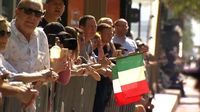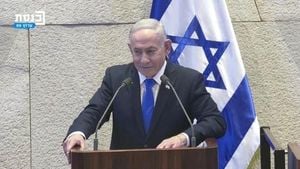Chicago’s downtown State Street was awash with color, music, and a palpable sense of heritage on October 13, 2025, as the city’s 73rd Annual Columbus Day Parade stepped off amid ongoing national debate about the holiday’s meaning. Organized by the Joint Civic Committee of Italian Americans (JCCIA), the parade drew hundreds of participants and onlookers, each bringing their own perspective to a day that has become emblematic of both pride and controversy.
The festivities began early in the morning, with a 9 a.m. mass at the Shrine of Our Lady of Pompeii on Lexington Avenue. According to organizers, this was followed by a solemn procession to Arrigo Park, where a wreath-laying ceremony honored Italian American war veterans—a tradition that underscores the deep roots and sacrifices of the Italian American community in Chicago.
By 11:45 a.m., the energy had shifted from reverence to celebration as opening ceremonies for the parade commenced at the corner of State Street and Wacker Drive. Just before 12:30 p.m., nearly 200 floats and organizations began their march south along State Street, eventually winding toward Van Buren Street. School marching bands, energetic dance troupes, local restaurant groups, and a host of Italian American committees filled the streets, creating a scene that was as much about unity as it was about heritage.
“The favorite part for me is the fact that everyone comes together. The Italian Americans, of course, are very proud, but you look around, people of all cultures coming together and celebrating this great day, that’s really what Columbus Day is all about,” JCCIA President Ron Onesti told FOX 32’s Kasey Chronis. His words resonated with many attendees, who lined the parade route with their families, enjoying a day off from work and school.
Denise Iosco, a lifelong resident of Melrose Park, attended with her daughters and grandsons. “I grew up in an Italian community and I’ve been there my whole life. My parents were also there their whole lives, my mom is still alive at 96 and we all live in Melrose Park, Illinois, which was traditionally Italian and we try to keep our heritage and culture alive, especially during holidays,” she shared, capturing the sentiment of many who see the parade as a vital link to their past.
Yet, the day was not without its reminders of a shifting cultural landscape. While Columbus Day remains a federal holiday, its meaning and observance have become increasingly contested. President Donald Trump, just days before the parade, signed a proclamation calling Christopher Columbus a “visionary,” stating that the holiday should be “reclaimed” from those who seek to “dishonor” the explorer’s memory. This move was a clear signal of the administration’s stance, a marked contrast to former President Joe Biden’s approach.
In 2021, President Biden became the first U.S. president to formally recognize Indigenous Peoples’ Day with a proclamation, acknowledging both Columbus Day and Indigenous Peoples’ Day that year. According to NBC Chicago, Biden’s decision was seen as a step toward recognizing the contributions of Native Americans and confronting the darker aspects of colonial history. In contrast, Trump’s 2025 proclamation made it clear he would not recognize both holidays simultaneously, setting the stage for continued debate.
Chicago itself is a microcosm of this national conversation. While many Illinois schools closed for Columbus Day, Chicago Public Schools (CPS) replaced the holiday with Indigenous Peoples’ Day in 2019 and has observed it ever since. The move reflects a broader trend across the U.S., where cities and states have increasingly chosen to recognize Indigenous Peoples’ Day as a means to honor Native American history and critique Columbus’ treatment of indigenous peoples.
Mayor Brandon Johnson added his voice to the conversation on Monday morning, choosing to commemorate Indigenous Peoples’ Day rather than Columbus Day. “This Indigenous Peoples’ Day, Chicago honors and celebrates the rich cultural heritage of one of the largest urban Indigenous communities in the country, and the history of our first residents, including the Council of the Three Fires: the Ojibwe, Odawa, and Potawatomi Nations, and many other tribes, such as the Miami, Ho-Chunk, Menominee, Sac, and Fox. Embodying the Soul of Chicago, our Indigenous communities continue to contribute to the life of this city, celebrating their heritage, practicing traditions, and caring for the land and waterways,” Johnson posted on X (formerly Twitter), as reported by FOX 32.
This duality was evident throughout the day. While the JCCIA celebrated Italian American pride and the legacy of Columbus, city officials and many residents reflected on the broader, more complex history of the land and its peoples. The parade itself, with its diverse participants and spectators, seemed to embody both the tensions and possibilities of such a multifaceted holiday.
One of the more visible symbols of this ongoing debate is the fate of the Christopher Columbus statue in Grant Park. Removed in 2020 amid protests and concerns for public safety, the statue’s pedestal has also since been taken down, and the platform near Roosevelt Road and Columbus Drive remains fenced off. The JCCIA has renewed its call for the statue’s reinstallation, seeing it as a vital piece of Italian American history. For others in the city, the removal represents a necessary reckoning with the past.
Indigenous Peoples’ Day, now observed in various forms across the nation, continues to gain traction as a way to honor the resilience and contributions of Native Americans. According to NBC Chicago, the day is meant to “recognize contributions made by Native Americans and detest Columbus’ treatment of native peoples.” Cities like Chicago are at the forefront of this shift, with public schools and city officials emphasizing the importance of acknowledging indigenous heritage.
Still, for many Italian Americans, the parade and the holiday remain a cherished tradition—a celebration of immigration, resilience, and community. The JCCIA’s message was clear: there is room for both remembrance and progress. As President Ron Onesti put it, “Indigenous Peoples’ Day, we have three holidays with them already, we welcome them, we love them, we want them to march with us, we want to march with them, we want to celebrate their day today as our day.”
As the last floats made their way down State Street and families drifted home, the city’s dual observance of Columbus Day and Indigenous Peoples’ Day left no doubt that the conversation is far from over. Chicago’s parade, in all its complexity and color, reflected a city—and a nation—still grappling with how best to honor its past while looking toward a more inclusive future.




